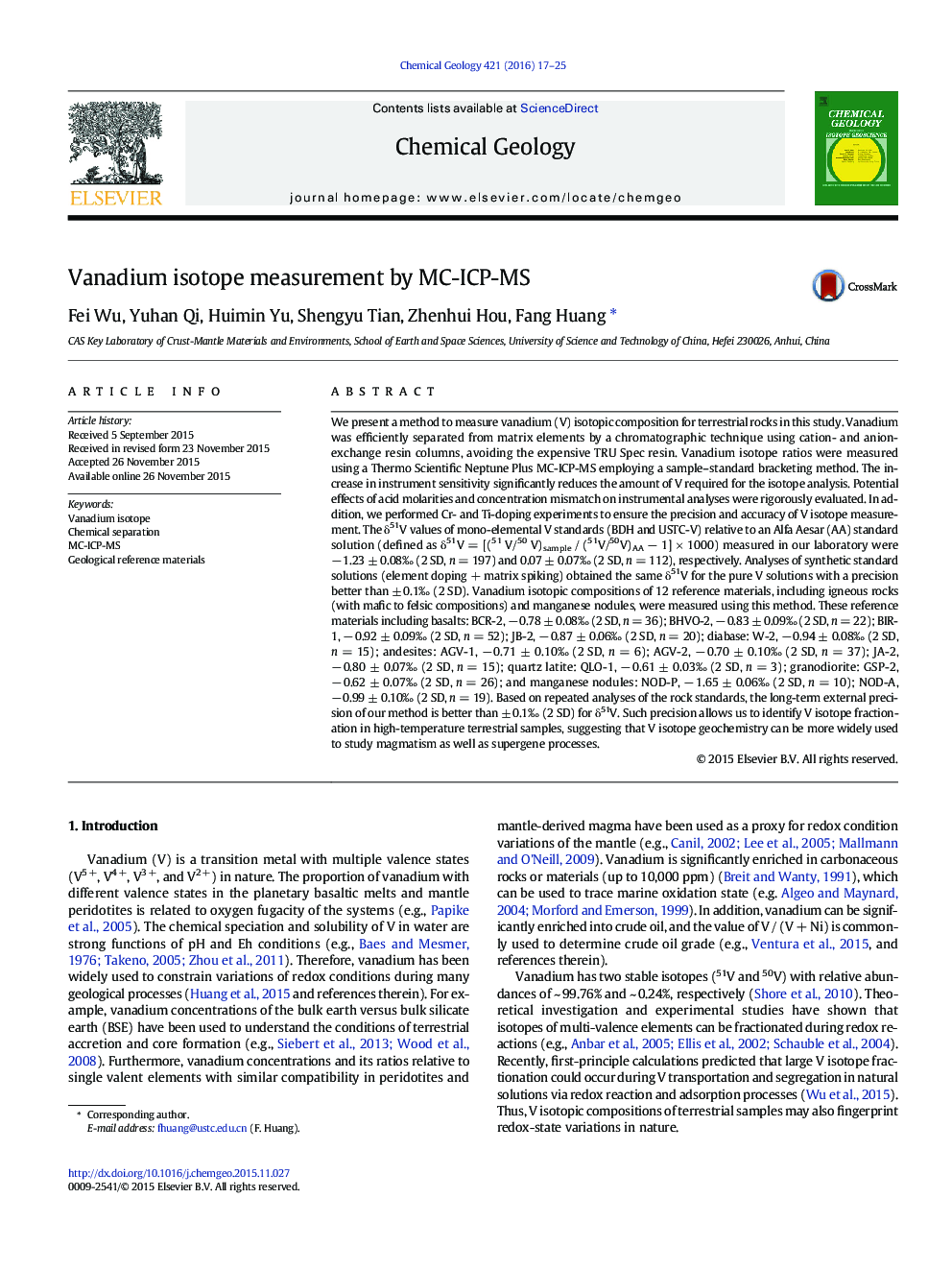| کد مقاله | کد نشریه | سال انتشار | مقاله انگلیسی | نسخه تمام متن |
|---|---|---|---|---|
| 6436169 | 1637553 | 2016 | 9 صفحه PDF | دانلود رایگان |

- V isotope compositions of 12 reference materials were measured by Neptune plus MC-ICP-MS using a modified method.
- The method significantly enhances time efficiency and reduces the amount of V required for isotope analysis.
- The long-term external precision of δ51V is better than ± 0.1Ⱐ(2 SD).
We present a method to measure vanadium (V) isotopic composition for terrestrial rocks in this study. Vanadium was efficiently separated from matrix elements by a chromatographic technique using cation- and anion-exchange resin columns, avoiding the expensive TRU Spec resin. Vanadium isotope ratios were measured using a Thermo Scientific Neptune Plus MC-ICP-MS employing a sample-standard bracketing method. The increase in instrument sensitivity significantly reduces the amount of V required for the isotope analysis. Potential effects of acid molarities and concentration mismatch on instrumental analyses were rigorously evaluated. In addition, we performed Cr- and Ti-doping experiments to ensure the precision and accuracy of V isotope measurement. The δ51V values of mono-elemental V standards (BDH and USTC-V) relative to an Alfa Aesar (AA) standard solution (defined as δ51V = [(51 V/50 V)sample / (51V/50V)AA â 1] Ã 1000) measured in our laboratory were â 1.23 ± 0.08â° (2 SD, n = 197) and 0.07 ± 0.07â° (2 SD, n = 112), respectively. Analyses of synthetic standard solutions (element doping + matrix spiking) obtained the same δ51V for the pure V solutions with a precision better than ± 0.1â° (2 SD). Vanadium isotopic compositions of 12 reference materials, including igneous rocks (with mafic to felsic compositions) and manganese nodules, were measured using this method. These reference materials including basalts: BCR-2, â 0.78 ± 0.08â° (2 SD, n = 36); BHVO-2, â 0.83 ± 0.09â° (2 SD, n = 22); BIR-1, â 0.92 ± 0.09â° (2 SD, n = 52); JB-2, â 0.87 ± 0.06â° (2 SD, n = 20); diabase: W-2, â 0.94 ± 0.08â° (2 SD, n = 15); andesites: AGV-1, â 0.71 ± 0.10â° (2 SD, n = 6); AGV-2, â 0.70 ± 0.10â° (2 SD, n = 37); JA-2, â 0.80 ± 0.07â° (2 SD, n = 15); quartz latite: QLO-1, â 0.61 ± 0.03â° (2 SD, n = 3); granodiorite: GSP-2, â 0.62 ± 0.07â° (2 SD, n = 26); and manganese nodules: NOD-P, â 1.65 ± 0.06â° (2 SD, n = 10); NOD-A, â 0.99 ± 0.10â° (2 SD, n = 19). Based on repeated analyses of the rock standards, the long-term external precision of our method is better than ± 0.1â° (2 SD) for δ51V. Such precision allows us to identify V isotope fractionation in high-temperature terrestrial samples, suggesting that V isotope geochemistry can be more widely used to study magmatism as well as supergene processes.
Journal: Chemical Geology - Volume 421, 10 February 2016, Pages 17-25